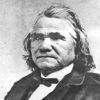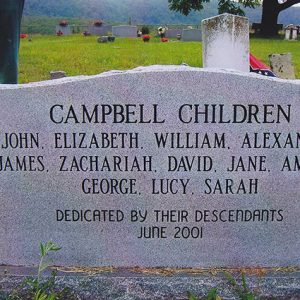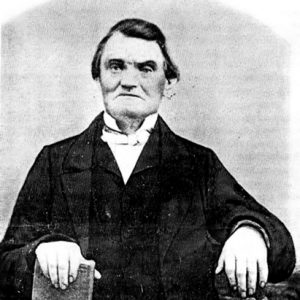calsfoundation@cals.org
John Campbell (1806–1879)
John Campbell was a Searcy County pioneer after whom the historic community of Campbell was named. He also served in both houses of the Arkansas General Assembly and was a second lieutenant during the Mexican War.
John Campbell was born on May 9, 1806, in Warren County, Tennessee, to James Campbell and Lucy Howard Campbell. Campbell became a colonel in the Tennessee militia while still in his twenties; he was usually called Colonel Campbell by his friends and neighbors. On July 29, 1835, he married Ann Blassingame in McNairy County, Tennessee. Following the birth of their son Charles Henry Campbell on September 4, 1837, the family traveled by ox cart on a six-week journey across the Mississippi River and up the White River, following an old Indian trail from Batesville (Independence County) to a sparsely settled region in Searcy County; he is said to be the first white settler to claim land in what is now Campbell Valley, in the foothills of the Boston Mountains.
Two years later, John Campbell’s brothers and sisters—Washington (Wash), James, Alex, and David, Margaret, Jane, Emily, Lucy, and Sarah—along with their families and parents from Tennessee, joined him following the same trail via a family wagon train. Another brother, Zach Campbell, migrated to Arkansas about the same time with his family but ended up in Scott County. Not long after their arrival, John Campbell moved his family several miles away to the northwest to a piece of land along Calf Creek, near what is today Snowball (Searcy County), where he built a pine log cabin for his new family. In this cabin, John and Ann raised six daughters and four sons.
Campbell’s land holdings consisted of 280 acres. Census records show no slaves, though an 1840 census for Searcy County shows one free “colored” person in the household, likely a house servant who came with the family from Tennessee. Row crops such as corn, oats, wheat, cane, tobacco, and cotton were grown on the rich bottomland along Calf Creek. He built a water-powered gristmill on upper Calf Creek, which attracted patrons from all around.
Campbell taught school and was elected to the county offices of surveyor (1838–1840) and county judge (1840–1842). He was elected to represent Searcy County in the Arkansas House of Representatives in 1842. His opponent in the elections of 1842 and 1852 was Samuel Leslie. Campbell is said to have had a hand in building the first Searcy County courthouse in Lebanon.
Campbell had been elected county coroner in 1846 when the Mexican War started. He enlisted with two of his brothers, David and Wash, on June 26, 1846, at Batesville as a sergeant in Company E, Captain C. H. Pelham’s Company, Arkansas Battalion Infantry and Mounted Rifles. He was elected second lieutenant on July 22, 1846. Campbell was stationed at Fort Gibson, where the battalion was used to patrol against Native Americans in the Indian Territory (present-day Oklahoma). He was discharged on February 28, 1847, at Fort Wayne, Cherokee Nation.
After the war, Campbell was an enumerator for the 1850 census, and in 1852 he was elected once more to represent Searcy County in the House of Representatives, where he was chosen as doorkeeper of the House. Campbell was also the first Freemason in Searcy County; the lodge at Marshall (Searcy County) bears his name, Campbell Lodge No. 115.
Campbell, who was a Whig in politics and opposed secession, befriended Fayetteville (Washington County) Whig David Walker. As a Searcy County representative at the second session of the Arkansas Secession Convention on May 6, 1861, Campbell was one of five who voted against leaving the Union. He eventually had a change of heart, influenced by Walker, who was president of the convention, and was the last to allow his vote to be changed in favor of secession. Subsequently, he enlisted in Company K of the Confederate Fourteenth Regiment, Arkansas Infantry (Powers), at Camp Adams near Yellville (Marion County) on August 5, 1861, reenlisting for two years at Corinth, Mississippi, on May 8, 1862, where he was elected first lieutenant on the same day. Campbell was captured at the fall of Port Hudson, Louisiana, on July 9, 1863, and spent the winter of 1863–64 in a parole camp in southern Arkansas awaiting his official exchange.
The war brought chaos and virtual anarchy to Searcy County. Campbell’s land was overrun with Union troops in January 1864, and his mill was destroyed. It is believed that, following his parole, Campbell and his family took refuge in Texas and did not return home until a degree of law and order had been reestablished in Searcy County. He was again living on his Calf Creek farm on the 1870 census.
Campbell began rebuilding, and he became an active member of the Democratic Party, being elected to two terms in the Arkansas Senate following the adoption of the Constitution of 1874. His last office was as Superintendent of State House of Records, which he held until his death in 1879.
Campbell died from diabetes on his farm on Calf Creek on November 10, 1879, and is buried alongside his wife in the Campbell Family Cemetery at Snowball.
For additional information:
Clemons, Veda Mae, ed. Searcy County, Arkansas: A History of Searcy County, Arkansas. Marshall, AR: Searcy County Retired Teachers Association, 1987.
Harrell, Mary Frances, ed. History and Folklore of Searcy County, Arkansas, Source Book. Harrison, AR: New Leaf Press, Inc., 1977.
Johnston, James J. Searcy County to 1850. Fayetteville, AR: Searcy County Publications, 1991.
———. Shootin’s, Obituaries, Politics: Emigratin’, Commercializin’, Socializin’, and the Press. Fayetteville, AR: Searcy County Publications, 1991.
Shiras, Ginger. “Finding Elbow Room in the Ozarks.” Arkansas Gazette, August 22, 1976, p. 5E.
Warren, Luther E. Yellar Rag Boys: The Arkansas Peace Society of 1861 and Other Events in Northern Arkansas, 1861 to 1865. Marshall, AR: Sandra L. Weaver, 1993.
Kenneth Rorie
Van Buren, Arkansas




 Campbell Children's Memorial
Campbell Children's Memorial  John Campbell
John Campbell 



Comments
No comments on this entry yet.